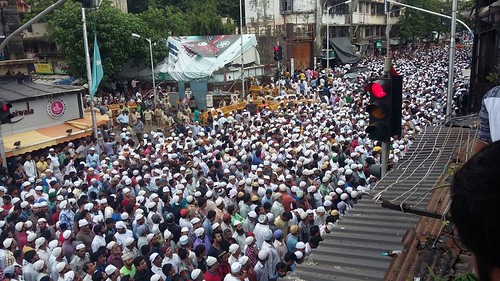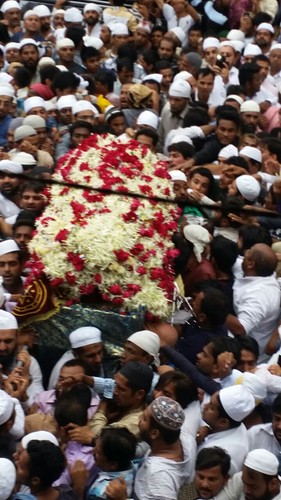By Irfan Engineer,
Media reported that about 8000 people attended the last journey of Yakub Memon – whom the Supreme Court had earlier convicted for the offence of being part of conspiracy to plant bombs in various places in Mumbai on 12th March 1993. 257 innocent lives were lost. Yakub Memon and was hanged to death on of 30th July 2015. Social media expressed their anguish towards those who attended the funeral in particular and the Muslim community in general. Some opined that the community was not willing to accept the conviction of Yakub by the Supreme Court while others insinuated that the attendees were supporters of terrorists and anti-national. Tripura Governor Tathagatha Roy tweeted that all those who attended the funeral, except family members of Yakub Memon, were potential terrorists.

We need to understand why there was such a huge turnout for Yakub Memon’s last rites. There is no denying that a section of Muslims empathised with Yakub. However that cannot be read as support for terrorism or terrorists of any hue or colour. The community knows the pain losing loved ones to hate crimes. After the 26/11/2008 attack by 10 Pakistani terrorists, including Ajmal Kasab, in which 164 people were killed, the Indian Muslim community refused burial for the 9 terrorists gunned down by the security personnel. Muslim organisations in Mumbai had announced that the doors of the cemeteries in which unclaimed bodies are usually buried will not open for the terrorists, as they were not the true followers of Islam (PTI, 2010).
This is not the first time that people have empathised with a criminal by attending his last rites. Large numbers of people turn out for dons belonging to various castes, ethnic and religious background. Those who attended the last rites of Phoolan Devi, were not necessarily insensitive toward the victims of her numerous dacoities. They perhaps remembered that she too was victim of caste oppression even though she may have chosen wrong method to fight it. They identified with her victimhood and were inspired by her courage to fight back – not necessarily with the means she chose. No one said at that time that all those attending Phoolan Devi’s last rites, except her family members, were potential dacoits. Many people, particularly Tamils in Dharavi, mourned the death of the gangster Vardarajan Mudaliar – contract killer in Mumbai (Wikipedia, n.d.). The mourners were not mourning loss of a contract killer.
Nearly 1.2 million people took part in the funeral procession of Bal Thackeray covering six km in just over five hours, forcing the police to shut down large parts of the city to traffic (ET Bureau, 2012). Bal Thackeray was condemned by Justice Madon Commission for his role in 1970 communal riots in Bhiwandi, Jalgaon and Mahad, and by Justice Srikrishna Commission for the riots 1992-93 communal riots in Mumbai. Srikrishna Commission found Bal Thackeray riding into the boiling cauldron that Mumbai was after the demolition of Babri Masjid “like a veteran general leading his troops.” It is a different matter that no efforts were made to bring Bal Thackeray to justice for his inflammatory hate speeches against Muslims and non-Maharashtrians and for leading his troops like a veteran general in riots. Bal Thackeray’s sainiks would be ready to execute any orders from him – kill trade union leaders, attack non-Maharashtrians, cinema halls, media offices and use strong arm tactics. He proudly proclaimed that he did not believe in lokshahi (democracy) but thokshahi (strong arm and coercion). All his thokshahi was while he was enjoying Z plus category security cover. Officially 900 people were killed in Mumbai 1992-93 communal riots, 575 of them were Muslims, 275 Hindus and 50 others (Nayar, 2015). Bal Thackeray was indicted by Justice Srikrishna Commission (Justice Srikrishna, 1998).
Empathy with persons in conflict with law
There are three reasons for empathy with persons in conflict with law (pcwl). One – of course, family members, even if disapproving the activity of the person could have empathy or at least a humanitarian duty of participating in the last rites of the person. Two – when people value contribution of the pcwl to their lives and their deeds perceived as heroic. Three – empathizers share the socio-economic background with the pcwl, particularly, those from the marginalized and oppressed sections like the oppressed and marginalised castes, ethnic groups or minority communities. They understand why the pcwl had to adopt means that were in conflict with law when they themselves experience powerlessness, subjugation, exploitation and marginalization within the legal framework. The pcwl to some extent limits and resists the power of their oppressors. People attending Phoolan Devi’s funeral empathized with her for this reason. The pcwl also share some of her/his booty with the needy among his/her marginalized community and in turn enjoys their support. Arun Gawli, from an OBC caste, was popular among the residents of Dagdi Chawl, Vardarajan was popular in Dharavi among the otherwise marginalized Tamil community largely drawn from SC and OBC castes.

The pcwls from marginalised sections are more like Robinhoods. They do not affect the structures of oppression, exploitation and marginalization. They ensure only a sense of honour and dignity and semblance of counter power and minor economic gains – e.g. marginal increase in wages or end to unpaid work for feudal oppressors, or employment in the pcwl’s occupation. The pcwls from the marginalized community cannot sustain themselves for long without finding for themselves safe havens in forests or ultimately end up working for the interest of dominant elite. The smugglers end up benefiting the industrialist and builders benefit from the land mafia.
Muslim Youth
Continuous exclusion, discrimination, lack of educational and livelihood opportunities, communal violence and marginalization, did lead to some Muslim youth too to be in conflict with law. Attack on sacred symbols and beliefs (claim to 3,000 mosques where temples existed) and subjugating them to brutal display of force and violence shakes their sense of self and community; shakes the foundation of their human existence.
A survivor in Muzaffarnagar started crying like a child seeing their mosque burnt down and told this writer he would never be able to return to the village where the mosque was burnt, it just did not make any sense, nor there would be any dignity left in doing so. In Atali village, Ballabhgarh, Haryana, the community was not allowed to put a roof over the place where they were praying for over 50 years! These are just not isolated examples. There have been numerous cases all over the country. Stigmatized for conducting “love jihad”, being terrorists, for the dress they wear, food they eat etc. and numerous leaders of Hindu nationalist organisations reminding Muslims that Gujarat and Muzaffarnagar can occur again. There is no hope of justice to the survivors of communal violence which has consumed 40,000 lives in independent India, including Mumbai, Bhiwandi, Ahmedabad, Meerut, Aligarh, Moradabad, Godhara, Sitamarhi, Bhagalpur, Nellie, and numerous other places. When a human rights activist like Teesta Setalvad struggles for justice to survivors of 2002 riots in Gujarat, the entire state tries to put her behind bars and calls her enemy of the state.
The community had its Haji Mastan, Karim Lala, Dawood Ibrahim, Tiger Memon and others. There is no gainsaying that all the Muslim youth accused by the security forces of terrorist activities are innocent. Conversely all of them are not guilty just because security forces have accused them to be terrorists. A large number of innocent youth are arrested accused of terror for ulterior motives and suffer incarceration for years together without bail as they are charged under draconian laws without any legal justification only to be discharged by courts as innocents. They return losing their prime years to a world of stigma and unemployment, sometimes forced out of professional courses they were pursuing at the time of their arrest. When the community loses hopes for justice, a few youth take upon themselves to dispense justice outside the legal framework. Their conflict with law is without any disapproval of the community. A section of the community even empathizes with them.
The survivors of communal violence did not get justice even when “secular” parties claiming to oppose communal politics like the Congress, RJD, SP and numerous others were at the helm. On the other hand, Hindu nationalist organizations and leaders of the BJP are aggressively communalizing the public discourse. The Muslim community, in spite of its sectoral, caste and biradari based, linguistic, cultural, jurisprudential and other diversities, divisions and political conflicts, feel under siege and there is an urge to unite politically and have a strong leader who would deliver justice – social, political and economic.
Asaduddin Owaisi of the AIMIM is trying to benefit from the situation and emerge as a ‘strong leader’ of the community and its sole spokesperson by cleverly choosing his discourse that sounds to be within the Constitutional framework and yet exploiting the victimhood feeling within the community. He targets and opposes every party that vie for support of the Muslim community. His political ambitions are to expand his party from Hyderabad based to an all India party and to mobilize all Muslim votes displacing the existing Muslim interest parties as well as other secular parties. Uniting the community under a Muslim interest party would serve the purpose of the Hindu nationalist organizations on one hand and the Muslim political elite belonging to ashraf biradaries (upper caste) on the other hand. Mobilization of Muslims on communal agenda pushes the Constitutional agenda of equality and social justice – empowerment of socially and educationally backward classes to the margins and makes it irrelevant.
Large turnout
Large turnout for Yakub Memon should be seen in this light. It would be a travesty of truth to read the turnout as support for the March 12, 1993 bombings in which 257 innocent people died or any insensitivity to the survivors of the bombings. There should not be any doubt that all those who were part of Yakub Memon’s funeral wanted all the guilty of the March 12 1993 bombings to be punished, including Yakub Memon. They believed that death penalty was excessive for the offence he committed and that there were extenuating circumstances. There were many non-Muslims too who believed that Yakub did not deserve death penalty for his crime. The media carried two versions. Those against capital punishment were presenting their “evidence” and arguments that Yakub Memon surrendered himself and disclosed to the investigation agencies all material particulars about the conspiracy. He therefore deserved lenient punishment. Whereas those supporting the capital punishment to Yakub Memon would argue that someone should be held accountable for the killing 257 innocent persons in the March 12 bombings in Mumbai and handed deterrent punishment; and that Yakub Memon being one of the conspirers deserved the punishment. When a significantly large number of Indians, irrespective of their religion and community held the opinion that Yakub should not have been hanged, why single out Muslims on the basis of their religion for holding such an opinion?
If the idea of India has to survive and the Constitutional vision has to survive, all Indians will have to come together build robust institutions for dispensing justice that is community, caste, nationality, ethnicity, gender and linguistic neutral; build institutions that privilege the socially and educationally backward irrespective of religion, gender, caste, ethnicity, but is not blind if injustices, exclusion, oppression and marginalization is being targeted against particular gender, caste, community, ethnicity, religion and nationality. We need to build accountable and responsible governance and participatory democracy. It is a just society that reduces crime. Victimization only produces “heroes” and a cycle of violence and counter violence no matter what deterrent punishment is handed out.
…….
( Irfan Engineer is Director of Mumbai based Centre for Study of Society and Secularism.)
